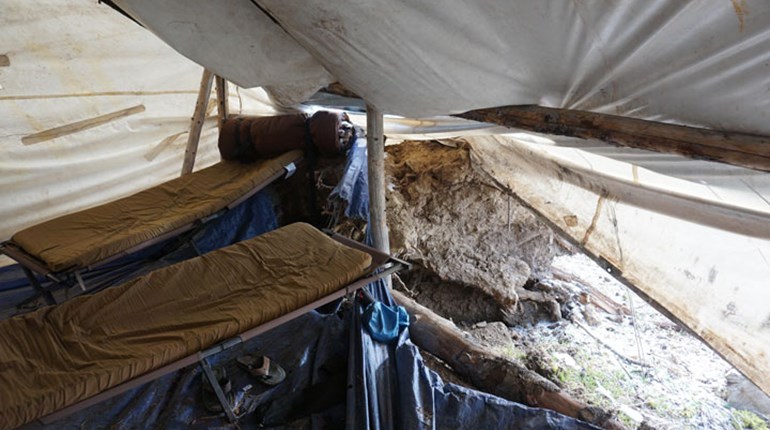
Triage
When you come upon an accident scene, the SOLO Wilderness First Aid course teaches you to first assess and evaluate the situation. SOLO calls it the Stop and Survive method.
Stop and take a deep breath. Calm down and evaluate the situation. Make sure nobody runs off for help or runs to the patient until you are sure it’s safe and the situation is under control.
Safely approach and assess the patient. As you encounter a problem, deal with it before proceeding. For example, if you see that the patient is not breathing, it’s important to start the breathing process immediately. If there is severe bleeding, stop it. All this is critical and a bit complicated. What you do here can be a big factor in the outcome.
Finally, come up with a plan to get help. Re-assess the patient and the situation while waiting for professional help to arrive.
Stop Bleeding
Another common wilderness injury is external bleeding from some type of soft-tissue injury. We hunters mess around with sharp stuff like knives, broadheads and axes, and accidents happen. (I have multiple scars to prove it!)
You are going to have to make decisions when dealing with bad injuries in the wilderness. The more training you have, the better able you are to make the right choices. For example, tourniquets are generally not used in a wilderness situation and must only be applied when the choice is between life and limb. A tourniquet will cut off the blood flow to the limb and may cause irreparable damage. On the other hand, if there is arterial bleeding that you cannot stop any other way and the patient is going to die, you may have to resort to using one.

It’s best to know all the other ways to stop bleeding so you are not forced into a tough decision. The key to stopping bleeding in most situations is direct pressure. Put a dressing on the wound and apply pressure. If blood soaks through the first dressing, put more dressings on top and maintain the pressure until the bleeding stops. Do not remove the first dressing; just keep adding more on top. Don’t have enough dressings? Use an extra layer of clothing that you may have in your pack, a space blanket, rain gear, whatever you have.
Ideally, you will have a first aid kit with an Israeli bandage or at least an Ace bandage. These can be very helpful in maintaining pressure on the wound. Wind them over a trauma pad placed on the wound, tight enough to apply pressure but not so tight as to cut off circulation.

With any kind of serious soft-tissue injury, once the bleeding has stopped, the wound must be cleaned well using clean water. Apply a sterile dressing and a bandage to hold the dressing in place and protect the wound. Follow-up care with professional medical help is likely in order.
Treat Heat Exhaustion
Know the difference between heat exhaustion and heat stroke. Heat exhaustion is not life-threatening, and patients often recover without professional care. But heat exhaustion can progress to heat stroke, which can lead to death without immediate care.
Symptoms of heat exhaustion include pale, cool, clammy skin. The victim’s consciousness level is normal or slightly anxious. Pulse is slightly increased. Blood pressure is normal. Respiration is normal or slightly increased. Have the victim rest in a cool place. Replace lost fluids and salts by giving him 1 teaspoon of salt and 2 tablespoons of sugar mixed in 1 liter of water, or Gatorade. Give fruit and/or fruit juice.
Heat stroke is life-threatening. It happens when a person becomes so dehydrated his sweating mechanism fails and his body temperature rises. In a hot, humid environment, sweat cannot evaporate fast enough to cool the person and regulate body temperature. Symptoms include red, hot skin. In half of victims, the skin will be dry; it will be wet with the other half. Body temperature is high. The maximum survivable core temperature is 105 degrees; 107 causes death. The person is disoriented, combative and hallucinating. Without treatment, he will pass into coma and die. Pulse is rapid and full; blood pressure may be elevated. Respiration is full and deep.

Prevent heat stroke by making sure you and others stay hydrated and eat salty foods. Keep your heads covered. Warning signs initially point to heat exhaustion and include an inability to urinate. The victim may feel hot and/or dry.
Seek immediate treatment. Remove the victim from the heat and sun. Cool him by soaking with water and fanning. Hydrate him and vigorously massage limbs. Watch for shivering, as this causes heat. Transport the person to a hospital.
From Frontline to Backcountry
Developed by Special Operations medics who love to hunt elk, Hunter’s Trauma Kits by TMS Outdoors contain essential medical gear our elite soldiers use in Afghanistan and Iraq. These aren’t full-blown first-aid kits; instead, they’re pared down to treat life-threatening bleeding while being easy to carry up a mountain.
“The lessons we learned in combat went into these kits,” says TMS Outdoors director of sales and U.S. Army Special Forces veteran Brandon Smith. “When you’re miles from help, you’ll have the tools you need to save a life.”
The basic kit’s main components are an SOF Tactical Tourniquet and a Tramedic pressure bandage, along with easy-to-understand instructions for their use. (TMS Outdoors has training videos on its website.) Other items include petroleum gauze, tape, antibiotic ointment, adhesive bandages, non-latex gloves and lip balm. All this fits into a 5x7-inch nylon pouch and weighs 13 ounces.






































